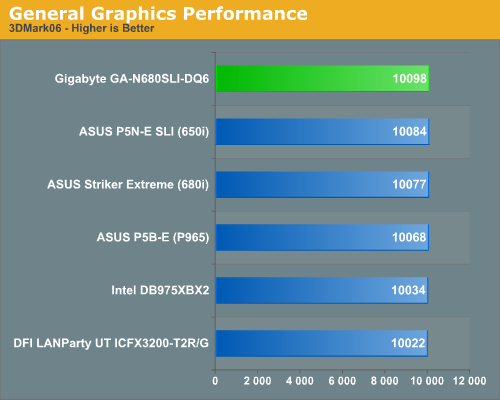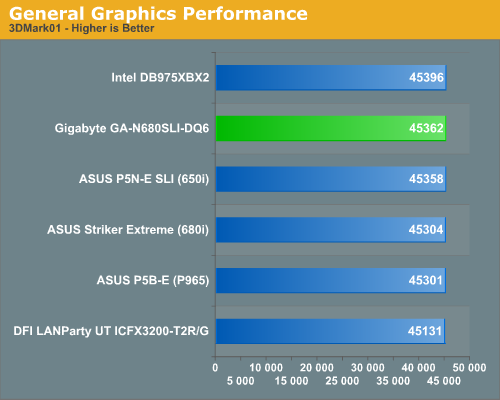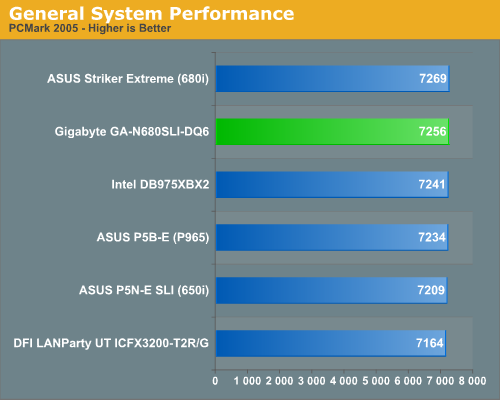Gigabyte GA-N680SLI-DQ6: Quad to the Extreme
by Gary Key on February 24, 2007 1:30 AM EST- Posted in
- Motherboards
Test Setup
A 2GB memory configuration is now standard in the AT test bed as most enthusiasts are currently purchasing this amount of memory. Our choice of high-end OCZ Flex XLC memory from OCZ offered a very wide range of memory settings during our stock and overclocked test runs. We also utilized our Corsair XMS2 Dominator (Twin2x2048-9136C5D) memory on this board to verify DDR2-1066 compatibility with another memory type. We are currently completing testing several other memory modules ranging from TwinMOS and WINTEC DDR2-800 down to A-DATA DDR2-533 for compatibility and performance benchmarks in our next article. We will also be looking at 4GB memory compatibility in future motherboard articles. Our memory timings are set based upon determining the best memory bandwidth via MemTest 86 and test application results for each board. We only optimize the four main memory settings with sub-timings remaining at Auto settings.
We are utilizing an MSI 8800GTX video card to ensure our 1280x1024 resolutions are not completely GPU bound for our motherboard test results. We did find in testing that applying a 4xAA/8xAF setting in some of today's latest games created a situation where the performance of the system starts becoming GPU limited, but compared to previous X1950 XTX testing we should have quite a bit more GPU headroom now. Our video tests are run at 1280x1024 resolution for this article at High Quality settings. We also tested at 1600x1200 and 1920x1200 4xAA/8xAF for our NVIDIA SLI results that will be presented in our upcoming 680/650i roundup.
All of our tests are run in an enclosed case with a dual optical/hard drive setup to reflect a moderately loaded system platform. Windows XP SP2 is fully updated and we load a clean drive image for each system to ensure driver conflicts are kept to a minimum.
Synthetic Graphics Performance
The 3DMark series of benchmarks developed and provided by Futuremark are among the most widely used tools for benchmark reporting and comparisons. Although the benchmarks are very useful for providing apple to apple comparisons across a broad array of GPU and CPU configurations they are not a substitute for actual application and gaming benchmarks. In this sense we consider the 3DMark benchmarks to be purely synthetic in nature but still very valuable for providing consistent measurements of performance.


In our 3DMark06 test, each platform score is basically the same although we see the DFI RD600 based motherboard trailing slightly. We attribute this to the latest released BIOS that has generated slightly lower performance results than our original test beta.
In the more memory and CPU sensitive 3DMark01 benchmark we see the Intel 975X board pulling away from the other boards due to its superior memory bandwidth at stock settings. Even though this holds true to some degree for the ASUS P5B-E based on the P965 chipset, we see it scoring slightly lower than our NVIDIA solutions due to relaxed MCH timings that allow it to excel in high FSB overclocking.
Although our Sandra memory bandwidth scores along with Memtest86 testing consistently show the RD600 performing slightly better than the 680i or 650i, but our 3D01 benchmark is not showing this advantage. NVIDIA based chipsets perform very well in graphics tests and the scores from our Intel DB975XBX2 indicate a highly tuned platform.
General System Performance
The PCMark05 benchmark developed and provided by Futuremark was designed for determining overall system performance for the typical home computing user. This tool provides both system and component level benchmarking results utilizing subsets of real world applications or programs. This benchmark is useful for providing comparative results across a broad array of GPU, CPU, Hard Disk, and Memory configurations along with multithreading results. In this sense we consider the PCMark benchmark to be both synthetic and real world in nature, and it provides consistency in our benchmark results.

The Gigabyte 680i is very competitive in this benchmark although we expected slightly better performance based upon our application results. The 650i and 680i chipsets scored very well on the single task disk benchmarks and both performed almost equally on the graphics subsystem tests where they led the field. However, our 975X and P965 chipset boards won the multi-tasking tests while the RD600 finished in the middle on most of the tests.
| Standard Test Bed Performance Test Configuration |
|
| Processor: | Intel Core 2 Duo E6600 (2.4GHz, 4MB Unified Cache) Intel Core 2 Extreme QX6700 (2.66GHz, 8MB Unified Cache) |
| RAM: | OCZ Flex XLC (2x1GB), 2.30V (Micron Memory Chips) |
| Hard Drive: | Western Digital 150GB 10, 000RPM SATA 16MB Buffer |
| System Platform Drivers: | Intel - 8.1.1.1010 NVIDIA - 9.35, 8.43 ATI - 6.10 |
| Video Cards: | 1 x MSI 8800GTX |
| Video Drivers: | NVIDIA 97.92 |
| CPU Cooling: | Tuniq 120 |
| Power Supply: | OCZ ProXStream 1000W |
| Optical Drive: | Plextor PX-760A |
| Case: | Cooler Master CM Stacker 830 |
| Motherboards: | ASUS Striker Extreme (NVIDIA 680i) - BIOS 1002 ASUS P5N-E SLI (NVIDIA 650i) - BIOS 0401 ASUS P5B-E (Intel P965) - BIOS 0402 B06 DFI LANParty UT ICFX3200-T2R/G (AMD RD600) - BIOS 12/22 GIGABYTE GA-N680SLI-DQ6 - BIOS F3B/F3A Intel D975XBX2 (Intel 975X) - BIOS 2333 |
| Operating System: | Windows XP Professional SP2 |
| . | |
A 2GB memory configuration is now standard in the AT test bed as most enthusiasts are currently purchasing this amount of memory. Our choice of high-end OCZ Flex XLC memory from OCZ offered a very wide range of memory settings during our stock and overclocked test runs. We also utilized our Corsair XMS2 Dominator (Twin2x2048-9136C5D) memory on this board to verify DDR2-1066 compatibility with another memory type. We are currently completing testing several other memory modules ranging from TwinMOS and WINTEC DDR2-800 down to A-DATA DDR2-533 for compatibility and performance benchmarks in our next article. We will also be looking at 4GB memory compatibility in future motherboard articles. Our memory timings are set based upon determining the best memory bandwidth via MemTest 86 and test application results for each board. We only optimize the four main memory settings with sub-timings remaining at Auto settings.
We are utilizing an MSI 8800GTX video card to ensure our 1280x1024 resolutions are not completely GPU bound for our motherboard test results. We did find in testing that applying a 4xAA/8xAF setting in some of today's latest games created a situation where the performance of the system starts becoming GPU limited, but compared to previous X1950 XTX testing we should have quite a bit more GPU headroom now. Our video tests are run at 1280x1024 resolution for this article at High Quality settings. We also tested at 1600x1200 and 1920x1200 4xAA/8xAF for our NVIDIA SLI results that will be presented in our upcoming 680/650i roundup.
All of our tests are run in an enclosed case with a dual optical/hard drive setup to reflect a moderately loaded system platform. Windows XP SP2 is fully updated and we load a clean drive image for each system to ensure driver conflicts are kept to a minimum.
Synthetic Graphics Performance
The 3DMark series of benchmarks developed and provided by Futuremark are among the most widely used tools for benchmark reporting and comparisons. Although the benchmarks are very useful for providing apple to apple comparisons across a broad array of GPU and CPU configurations they are not a substitute for actual application and gaming benchmarks. In this sense we consider the 3DMark benchmarks to be purely synthetic in nature but still very valuable for providing consistent measurements of performance.


In our 3DMark06 test, each platform score is basically the same although we see the DFI RD600 based motherboard trailing slightly. We attribute this to the latest released BIOS that has generated slightly lower performance results than our original test beta.
In the more memory and CPU sensitive 3DMark01 benchmark we see the Intel 975X board pulling away from the other boards due to its superior memory bandwidth at stock settings. Even though this holds true to some degree for the ASUS P5B-E based on the P965 chipset, we see it scoring slightly lower than our NVIDIA solutions due to relaxed MCH timings that allow it to excel in high FSB overclocking.
Although our Sandra memory bandwidth scores along with Memtest86 testing consistently show the RD600 performing slightly better than the 680i or 650i, but our 3D01 benchmark is not showing this advantage. NVIDIA based chipsets perform very well in graphics tests and the scores from our Intel DB975XBX2 indicate a highly tuned platform.
General System Performance
The PCMark05 benchmark developed and provided by Futuremark was designed for determining overall system performance for the typical home computing user. This tool provides both system and component level benchmarking results utilizing subsets of real world applications or programs. This benchmark is useful for providing comparative results across a broad array of GPU, CPU, Hard Disk, and Memory configurations along with multithreading results. In this sense we consider the PCMark benchmark to be both synthetic and real world in nature, and it provides consistency in our benchmark results.

The Gigabyte 680i is very competitive in this benchmark although we expected slightly better performance based upon our application results. The 650i and 680i chipsets scored very well on the single task disk benchmarks and both performed almost equally on the graphics subsystem tests where they led the field. However, our 975X and P965 chipset boards won the multi-tasking tests while the RD600 finished in the middle on most of the tests.










12 Comments
View All Comments
sirius4k - Thursday, May 17, 2007 - link
Overview in Gigabyte' website said there will be some eSATA (Quad eSATA or something) ports. On this preview... read panel indicates no eSATA ports :S---
No eSATA means going back to Striker Extreme... of course.
yacoub - Friday, March 30, 2007 - link
The reviews at NewEgg are tearing this board a gaping butthole. I'm staying away. :[Gary Key - Monday, April 2, 2007 - link
Every review at NewEgg was either a four or five star rating for this board. Where are the bad ones?Binkt - Monday, March 19, 2007 - link
Can someone over there put in a few PCI-E RAID cards in those extra PCI-E slots and see if they function? The Areca SATA RAID cards (ARC-12x0ML) are what I'm looking at right now. Pretty please?!There is a rather cryptic FAQ entry on using PCI-E for "graphics" slots on Areca's website in regards to this subject. I'd just like some more physical validation before plunking down the green.
erwos - Monday, February 26, 2007 - link
Am I the only one who's totally and utterly confused as to why this board has four ethernet interfaces? I can see using two interfaces. I could even contemplate three for really weird setups. But what networking setup requires four gigabit interfaces? Are they supposed to be bonded, or used for fail-over?Speaking purely as a gamer, the MSI P6N Diamond looks like a better deal. It may be shorter on the ports, but that built-in X-Fi seems a lot more handy than a couple more SATA and ethernet ports.
Gary Key - Monday, February 26, 2007 - link
1. XP Professional will show 3.25GB of RAM when 4GB is installed. The board will show 4GB at POST.2. The RAM timings will drop with 4 x1GB when overclocking, at stock speeds with the F3 BIOS they require an additional .0125V to operate at the same timings.
3. The timings matter when using 2x2GB compared to 2x1GB,512MB, however at same timings we found 2X2GB was generally more stable and performance did not vary more than a percent or two.
4. If you use a 32-bit OS such as XP you are limited to 3.25GB of usable memory space.
5. This board did not have an issue with Vista-64 and recognizing 4GB or 8GB of memory, as stated in the article we are still conducting memory compatibility testing as certain modules perform better than others (stability, voltages, timings), even though they are based on the same IC. Gigabyte still has some tuning work to do in this area.
Thanks, more information will be in the roundup.
anandtech02148 - Saturday, February 24, 2007 - link
per example dfi infity 975g requireds 300watts just to post.also what is the idle /load for this? more electricity mo heat.
cornfedone - Saturday, February 24, 2007 - link
...or don't. As long as gullible, foolish fanboys buy these defective products, there is no FINANCIAL incentive for these unscrupulous companies to change their ways and deliver quality products.Obviously if every hardware review site on the planet can duplicate the unending operational (and often design/engineering) defects in these mobos, then certainly the mobo and chip makers could detect these defects BEFORE they ship this crap if they weren't intentionally pumping garbage out the door to suckers willing to pay $200 plus for a mobo that is a total POS.
There is absolutely NO reason to release a defective hardware product today other than financial greed and/or technical incompetence. Hell most of the Asian mobo companies can't even make a friggin quality copy of a reference mobo from AMD or ATI so why would you expect them to deliver a properly functioning "performance mobo" priced at hundred of dollars more when they can't buy a clue?
With any luck all of the slimy mobo makers will go tits-up soon and the real mobo companies will see an opportunity to provide quality mobos to the marketplace. At $200 a copy there is one Helleva incentive for honest, competent mobo companies to step forward and waste the Asian scum who are dumping crap into the marketplace. When a $200 plus mobo causes data corruption it's time for a massive class action lawsuit to end this consumer fraud and exploitation.
Now is the time.
sdsdv10 - Tuesday, February 27, 2007 - link
Cornfedone, what major motherboard manufacturer isn't in Asia? It appears you are painting all the current companies with the same bruch, Asus, Gigabyte, abit... Who would be left to be the "honest, competent mobo companies"?
tuteja1986 - Sunday, February 25, 2007 - link
Well Gigabyte GA-N680SL-DQ6 isn't even selling it. It will sale next month. They still have time to fix the bugs. Anyways i say buying the striker at launch for $400 was a foolish thing to do since it was buggy as hell. It took for them months to fix the problem.